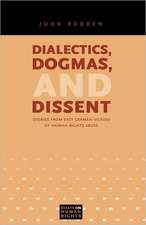Walls That Remain: Eastern and Western Germans Since Reunification
Autor John Roddenen Limba Engleză Hardback – 15 feb 2007
Preț: 767.47 lei
Preț vechi: 1029.34 lei
-25% Nou
Puncte Express: 1151
Preț estimativ în valută:
146.86€ • 153.72$ • 122.23£
146.86€ • 153.72$ • 122.23£
Carte tipărită la comandă
Livrare economică 31 martie-14 aprilie
Preluare comenzi: 021 569.72.76
Specificații
ISBN-13: 9781594513794
ISBN-10: 1594513791
Pagini: 320
Dimensiuni: 152 x 229 x 27 mm
Greutate: 0.64 kg
Ediția:1
Editura: Taylor & Francis
Colecția Routledge
Locul publicării:Oxford, United Kingdom
ISBN-10: 1594513791
Pagini: 320
Dimensiuni: 152 x 229 x 27 mm
Greutate: 0.64 kg
Ediția:1
Editura: Taylor & Francis
Colecția Routledge
Locul publicării:Oxford, United Kingdom
Recenzii
“This book is a truly impressive work. It is beautifully conceived and executed, as well as intellectually and morally engaging. Above all, it is so very well-written with a lively style, a tempered wit, a remarkable literary and historical erudition, and a refreshing human empathy. The portraits are robust and dominant. I could swear that some of Rodden’s conversation partners have crossed my path over the years, under different names to be sure.”
—Christian Soe, California State University at Long Beach
“This book makes a valuable contribution to our understanding of the functioning of dictatorship as well as to the general processes of social change. I am most impressed by the beautiful essayistic style and sovereign command of German conversational language and everyday slang. This is an excellent book that will be of great value to the scholar and general reader alike.”
—Karl-Heinz Fuessl, Institute for Education and History, Humboldt University, Berlin
“One of the most appealing features of the book is Rodden’s lively, witty, and forceful writing style. This style is thoroughly compatible with the book’s sound scholarship, because it serves to highlight his basic themes by giving dramatic power to various anecdotes, personal encounters, and historical scenes. Most engaging is Rodden’s very personal viewpoint in his portraits of the East Germans that he interviewed. His vignettes show vividly the fateful determination of German lives by history, and the poignant, sometimes humorous tone brings his nuanced yet sympathetic American perspective into the foreground, often mitigating the gloom and endowing the tragedy with promise and hope.”
—Walter Sokel, University of Virginia
“This stimulating book is written with grace. It is a fascinating portrait gallery of GDR life. I was particularly intrigued with the latter material given my extensive contact with GDR citizens from 1988 on.”
—Randall Bytwerk, Calvin College
“I have been most impressed by Rodden’s scholarly expertise, profound philosophical grasp, and power of verbal and intellectual expression. His book is fascinating, sometimes even thrilling to read, and it addresses a public far beyond academic specialists. It is accessible to the general reader and deserves the widest possible audience. He has an unusual stance that is both sympathetic and critical at the same time, and it facilitates his penetrating understanding of the essential purposes and aspirations of GDR education and cultural politics. I say all this as a man who himself lived through most of the history of GDR educational and cultural politics, first as a supporter of the regime and then, beginning in the mid-1980s, increasingly in opposition to the dictatorship—and who experienced the events of 1989–1990 as a personal and intellectual liberation from an ideological straitjacket. I can, therefore, on the basis of my own intimate knowledge of that history, evaluate with great confidence the outstanding achievement of this book as a work of scholarship and human empathy.”
—Wolfgang Strauss, University of Jena
—Christian Soe, California State University at Long Beach
“This book makes a valuable contribution to our understanding of the functioning of dictatorship as well as to the general processes of social change. I am most impressed by the beautiful essayistic style and sovereign command of German conversational language and everyday slang. This is an excellent book that will be of great value to the scholar and general reader alike.”
—Karl-Heinz Fuessl, Institute for Education and History, Humboldt University, Berlin
“One of the most appealing features of the book is Rodden’s lively, witty, and forceful writing style. This style is thoroughly compatible with the book’s sound scholarship, because it serves to highlight his basic themes by giving dramatic power to various anecdotes, personal encounters, and historical scenes. Most engaging is Rodden’s very personal viewpoint in his portraits of the East Germans that he interviewed. His vignettes show vividly the fateful determination of German lives by history, and the poignant, sometimes humorous tone brings his nuanced yet sympathetic American perspective into the foreground, often mitigating the gloom and endowing the tragedy with promise and hope.”
—Walter Sokel, University of Virginia
“This stimulating book is written with grace. It is a fascinating portrait gallery of GDR life. I was particularly intrigued with the latter material given my extensive contact with GDR citizens from 1988 on.”
—Randall Bytwerk, Calvin College
“I have been most impressed by Rodden’s scholarly expertise, profound philosophical grasp, and power of verbal and intellectual expression. His book is fascinating, sometimes even thrilling to read, and it addresses a public far beyond academic specialists. It is accessible to the general reader and deserves the widest possible audience. He has an unusual stance that is both sympathetic and critical at the same time, and it facilitates his penetrating understanding of the essential purposes and aspirations of GDR education and cultural politics. I say all this as a man who himself lived through most of the history of GDR educational and cultural politics, first as a supporter of the regime and then, beginning in the mid-1980s, increasingly in opposition to the dictatorship—and who experienced the events of 1989–1990 as a personal and intellectual liberation from an ideological straitjacket. I can, therefore, on the basis of my own intimate knowledge of that history, evaluate with great confidence the outstanding achievement of this book as a work of scholarship and human empathy.”
—Wolfgang Strauss, University of Jena
Cuprins
List of Abbreviations, Acknowledgments, Prologue: Division Day, or Barbed-Wire Sunday... and After, Introduction: The New Germanies: West-Side Stories, East-Side Stories, Part One: Berlin, West and East, 1. In the Shadow of the Holocaust, 2. Horror Tales from the “Land of Reading”, Part Two: Germany, East and West, 3. Leipzig: The God That Failed, 4. Plauen/Leipzig: Marks iiber Marx, 5. Tiibingen: The Great Red Hope?, 6. Weimar: Class(room) Conflict, 7. O Buchenwald!, 8. Rocken/Weimar: Resurrection of the Antichrist?, 9. Staufen in Breisgau: Recalling the “Hitler Olympics”, 10. The “Munich Massacre ” at 30, 11. Kassel: Of War Crimes and Contrition, Part Three: Through American Eyes, From Afar, 12. Soul Murder in the Grass, 13. Germany’s Not-So-Little Black Book, 14. Power, Forgiveness, and Schindler’s List, 15. The German Banana Republic, R.I.P?, Epilogue: (Dis)Unity Day? The Promises and Perils of October 3, Glossary, Index, About The Author
Descriere
The Walls That Remain explores the trauma of German reunification in 1990 as it affected ordinary Eastern and Western Germans.





